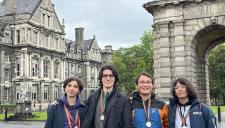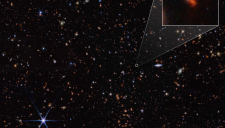The results of the SALSA program appear in a study by an international team of researchers, including Eva Ntormousi of the Scuola Normale Superiore published in The Astrophysical Journal.
PISA, June 16 2023. For decades, astronomers have studied the forces that govern the interior of galaxies - gravity, kinematic energy, stellar radiation, gas pressure - but magnetic fields are almost completely unknown. Magnetic fields may be a fundamental part of the evolution of galaxies, dragging interstellar gas towards the supermassive black hole, regulating the rate at which new stars form, influencing the formation of molecular gas clouds, and even affecting the internal kinematics of the disks of spiral galaxies.
Magnetic fields are intrinsically difficult to detect. While their field lines lurk between the stars and gas clouds that comprise galaxies, they do not emit any light on their own. Like in Earth’s atmosphere where dense clouds tend to bring more rain, molecular clouds form more stars than diffuse phases of the gas. Magnetic fields are amplified inside these dense clouds - where most stars are formed and where optical telescopes (like Hubble Space Telescope) cannot reach. So astronomers need to use specialized telescopes to detect their effects.
One of these instruments is the High-resolution Airborne Wideband Camera (HAWC+) on board the Stratospheric Observatory for Infrared Astronomy (SOFIA). Its sensitivity to the far-infrared region of the electromagnetic spectrum allows HAWC+ to observe the effects of magnetic fields deep in the cold, dark molecular clouds. HAWC+ observed the far-infrared, polarized light emitted by magnetically aligned dust grains.
An international team of scientists, including Eva Ntormousi, astrophysicist at the Scuola Normale in Pisa, working on a project called SALSA (Survey on extragALactic magnetiSm with SOFIA) has used HAWC+ to observe 15 galaxies in the neighborhood of the Milky Way. They mapped the far-infrared magnetic fields and compared their structures with those obtained in the radio with the Very Large Array in New Mexico and the Effelsberg telescope in Germany, both of which are sensitive to the less dense gas of the galaxies.
The results show that the structure of the magnetic field traced by SOFIA in spiral galaxies is more disordered than that traced by the radio telescopes. Spiral galaxies tend to have spiral magnetic field patterns, following the morphological arms made of gas and stars. However, the magnetic fields obtained with SOFIA are more chaotic and less ordered than those observed with radio telescopes. This could be the result of a small magnetic dynamo: a mechanism to amplify magnetic fields inside the molecular clouds.
SALSA also included Starburst galaxies - galaxies forming stars at an incredibly high rate, often as a consequence of a recent galactic collision or other gravitational disruptions. SALSA results show that SOFIA is more effective in tracing the magnetic field aligned parallel to the direction of these galactic outflows than radio telescopes. Radio telescopes, on the other hand, tend to be more sensitive to the magnetic fields present in the diffuse gas of the host galaxies. In some particular galaxies, like NGC 2146, SOFIA is able to distinguish between the magnetic field of the galactic outflows and that of the host galaxy by using maps at different wavelengths obtained with HAWC+.
SALSA results in this sample of 15 nearby galaxies show that the far-infrared observations of SOFIA are able to trace a less-ordered phase of the magnetic field than the radio polarization observations. Far-infrared light, emitted by the magnetically aligned dust grains present inside the cold, dense interstellar medium, proves that magnetic fields are intrinsically related to star formation and that their amplification may be triggered by the very same processes that form new stars.
SALSA finds that the magnetic fields in turbulent, dense, star-forming clouds of gas are more disordered than those in diffuse interstellar gas traced by radio telescopes. Different wavebands (far-infrared, radio) reveal different layers of the structure of magnetic fields. High-resolution, far-infrared polarization observations of galaxies such as those provided by SOFIA/HAWC+ until its last flight in September 2022 are vital to understanding the role of magnetic fields in the evolution of the Universe.












